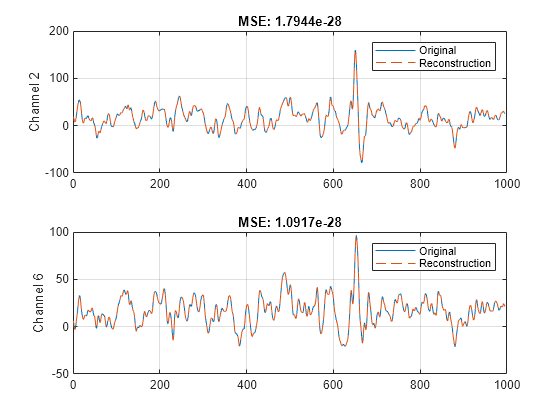dlicwt
Description
Examples
Load the Espiga3 EEG dataset. The data consists of 23 channels of EEG sampled at 200 Hz. There are 995 samples in each channel. Save the multisignal as a dlarray, specifying the dimensions in order. dlarray permutes the array dimensions to the "CBT" shape expected by a deep learning network.
load Espiga3 Fs = 200; [N,ch] = size(Espiga3); dlx = dlarray(Espiga3,"TCB"); whos Espiga3 dlx
Name Size Bytes Class Attributes Espiga3 995x23 183080 double dlx 23x1x995 183134 dlarray
dims(dlx)
ans = 'CBT'
Create a CWT filter bank that is compatible with the channels. Specify periodic boundary conditions. Then use the cwtfilters2array function to convert the filter bank to a reduced-weight tensor suitable for deep learning. Include the lowpass filter in the tensor.
fb = cwtfilterbank(SignalLength=N,SamplingFrequency=Fs, ... Boundary="periodic"); [psifvec,filteridx] = cwtfilters2array(fb,IncludeLowpass=true);
Obtain the deep learning CWT of the multisignal.
dlcfs = dlcwt(dlx,psifvec,filteridx);
whos dlcfsName Size Bytes Class Attributes dlcfs 72x23x1x995 26363528 dlarray complex
dims(dlcfs)
ans = 'SCBT'
To reconstruct the signal, compute the deep learning inverse CWT.
dlxrec = dlicwt(dlcfs,psifvec,filteridx);
whos dlxrecName Size Bytes Class Attributes dlxrec 23x1x995 183086 dlarray
dims(dlxrec)
ans = 'CBT'
Convert the output to a numeric array. To match the dimensions of the original multisignal, permute the output dimensions to correspond with the "TCB" format. The result is a matrix because there is only one batch.
xrec = extractdata(dlxrec); xrec = permute(xrec,[3 1 2]); whos xrec Espiga3
Name Size Bytes Class Attributes Espiga3 995x23 183080 double xrec 995x23 183080 double
Choose two of the channels. Compare the original channel with its reconstruction.
channelIdx = [2 6]; tiledlayout(2,1) for k=1:2 idx = channelIdx(k); nexttile xorig = Espiga3(:,idx); xreco = xrec(:,idx); plot(xorig) ylabel("Channel "+num2str(idx)) hold on plot(xreco,"--") hold off legend("Original","Reconstruction") title("MSE: "+mean((xorig-xreco).^2)) grid on end

Input Arguments
Continuous wavelet transform, specified as a formatted or unformatted dlarray (Deep Learning Toolbox) or
numeric array. cfs is the CWT of a real-valued signal.
If
cfsis a formatteddlarray, it must be in the"SCBT"or"CBT"format.If
cfsis in the"CBT"format, thedlicwtfunction unflattenscfsto the"SCBT"shape.If
cfsis real-valued, the number of channelsCmust be even because thedlicwtfunction assumes that the true number of channels isC/2.If
cfsis an unformatteddlarray, it must be compatible with the"SCBT"or"CBT"formats and you must setDataFormat.
The dlicwt function computes the inverse CWT along the
"S" dimension of cfs. The
"S" dimension corresponds to scale, or equivalently, the center
frequency of the wavelet bandpass filters.
Data Types: single | double
Complex Number Support: Yes
Reduced-weight CWT filter bank, specified as a real-valued
1-by-1-by-Nr tensor, where Nr is the number of
weights in the filter bank. Use cwtfilters2array to obtain psifvec.
Data Types: single | double
Bookkeeping matrix, specified as a matrix. In order to invert the CWT, the
dlicwt function uses filteridx and
psifvec to reconstruct an approximation to the CWT filter bank.
Use cwtfilters2array to obtain filteridx.
You can use array2cwtfilters to reconstruct the CWT filter bank from
psifvec and filteridx.
CWT format, specified as a character vector or string scalar. This argument is valid
only if cfs is unformatted.
Each character in this argument must be one of these labels:
"S"—Spatial (scale) dimension"C"— Channel"B"— Batch observations"T"— Time
The dlicwt function accepts any permutation of
"CBT" or "SCBT". Each element of the argument
labels the matching dimension of cfs. You can specify at most one
of each of the "S", "C", "B",
and "T" labels.
Example: x = dlicwt(cfs,psifvec,filteridx,DataFormat="SBCT")
specifies the format of the unformatted dlarray object
cfs as "SBCT".
Output Arguments
Reconstructed signal, returned as a formatted or unformatted
dlarray object.
If
cfsis a formatteddlarray, thenxis a"CBT"formatteddlarray.If
cfsis an unformatteddlarray, thenxis an unformatteddlarray. The dimension order inxis"CBT".
Data Types: single | double
Extended Capabilities
The dlicwt function
fully supports GPU arrays. To run the function on a GPU, specify the input data as a gpuArray (Parallel Computing Toolbox). For more information, see Run MATLAB Functions on a GPU (Parallel Computing Toolbox).
Version History
Introduced in R2024b
See Also
Functions
dlcwt|cwt|icwt|cwtfilters2array|array2cwtfilters|cwtmag2sig
Objects
Topics
- List of Functions with dlarray Support (Deep Learning Toolbox)
MATLAB Command
You clicked a link that corresponds to this MATLAB command:
Run the command by entering it in the MATLAB Command Window. Web browsers do not support MATLAB commands.
Select a Web Site
Choose a web site to get translated content where available and see local events and offers. Based on your location, we recommend that you select: .
You can also select a web site from the following list
How to Get Best Site Performance
Select the China site (in Chinese or English) for best site performance. Other MathWorks country sites are not optimized for visits from your location.
Americas
- América Latina (Español)
- Canada (English)
- United States (English)
Europe
- Belgium (English)
- Denmark (English)
- Deutschland (Deutsch)
- España (Español)
- Finland (English)
- France (Français)
- Ireland (English)
- Italia (Italiano)
- Luxembourg (English)
- Netherlands (English)
- Norway (English)
- Österreich (Deutsch)
- Portugal (English)
- Sweden (English)
- Switzerland
- United Kingdom (English)